Organic Olive Oil Market Research, 2031
The global organic olive oil market size was valued at $932.6 million in 2021, and is projected to reach $2.2 billion by 2031, growing at a CAGR of 8.9% from 2022 to 2031.
Organic olive oil products is widely marketed as the absence of chemical residues associated with synthetic fertilizers and plant protection products (PPPs). Organic olive oil is a common ingredient in foods, cosmetics, medicines, soaps, and traditional lamps. Originally from the Mediterranean, products in the organic olive oil market are now consumed all over the world. Olives can be consumed whole or chopped up and added to pizzas and other foods. Olive oil can be used in cooking, as a salad dressing, as a dip for bread, and for drizzling on pasta, hence propelling the growth in the organic olive oil market. For therapeutic purposes, populations across the globe consume products such as extra virgin olive oil in the organic olive oil market on daily basis.
According to European Commission, 67% of the world's olive oil is produced in Europe. A further 4 million hectares of land are used for olive tree farming, especially in Mediterranean nations, including France, Portugal, Italy, Spain, Greece, Malta, and Cyprus. Furthermore, 53% of the olive oil consumed worldwide is consumed in Europe, which stimulates the need for products in the organic olive oil market. The best olives in the world are offered for sale in France, the UK, Germany, the Netherlands, Switzerland, and Belgium. The need for healthier foods and the Mediterranean diet, as well as changes in European consumers' consumption patterns, are driving the organic olive oil market growth. Approximately 1.5 million tons of olive oil, or 50% of the world's production, are consumed within the EU each year. The EU is also the largest producer and exporter of olive oil, shipping over 570,000 tons annually.
Furthermore, the entire human body receives its energy from the digestive system. It essentially acts as the body's support system for the other systems. Several very painful digestive illnesses can occur when the digestive system is out of balance as a result of an unequal ratio of beneficial to harmful microbes, leading to chronic inflammation and a slew of other unpleasant symptoms. Consumption of organic olive oil encourages the production of peptides, which support healthy digestion and help with nutrient absorption, thus likely to boost the demand in the organic olive oil market forecast period. Regular use of olive oil promotes the gut's ability to only absorb the nutrients it requires and eliminate the remainder as waste, preserving gut health. Consequently, using organic olive oil to treat digestive disorders is expected to provide a boost to the organic olive oil market growth.
Products from the organic olive oil market are available across a variety of industries for skincare products. Additionally, it is considered a natural moisturizer that works anywhere. Polyphenols, which are also considered to be one of the oil's best health advantages and can be used to improve the appearance of the skin, are also among the most crucial elements of organic olive oil. For a number of head-to-toe skin care procedures, organic olive oil can be a healthy substitute for abrasive, chemical-laden cleansers and lotions. In addition, it can be used as a moisturizer, body scrub, olive oil bath, cuticle and nail softener, and makeup remover. As more individuals learn about the advantages of using organic olive oil for skin care, the market for this product is expanding. Therefore, there is expected to be a large increase in demand for products in the organic olive oil market during the forecast period due to the advantages it has over conventional olive oil.
Aromatherapy uses therapeutic essential oils, such as organic extra virgin olive oil, hence huge demand from diverse industries is expected to boost the growth of the organic olive oil market. Aromatherapy has been used for thousands of years to provide various benefits to people such as managing pain, relieving stress & anxiety, and offering them unusual experiences. Additionally, since the scent molecules in organic olive oil travel directly from the olfactory nerves to the brain when inhaled they help in alleviating the mood. Extra virgin olive oil also improves circulation, lymphatic drainage, and lowers stressful and depressing conditions and propelling demand in the organic olive oil market.. Although the analgesic effects of massage are widely known, applying deep friction massage techniques to the skin has even greater benefits. The nourishing and moisturizing benefits of extra virgin olive oil also cause the skin to become more flexible. It increases local blood flow even further and protects against burns and other muscle and skin issues when combined with vigorous friction massage. Therefore, the flavor and other qualities of organic olive oil are anticipated to have a positive impact on the market for organic olive oil.
However, organic olive oil may result in gastrointestinal problems because of its high fat content and potent purgative properties. As a result, customers are likely to switch to other types of edible oil, such as grapeseed, canola, sunflower, coconut, walnut, peanut, and avocado oils. In these sectors, substitute products frequently offer the same advantages as organic olive oil. Additionally, because grapeseed oil has a mild flavor, it can be used in place of olive oil while preparing foods like vegetables and proteins, which have strong flavors. Canola oil is a multipurpose cooking oil that may be used in sauces, salad dressings, frying, and grilling, much like olive oil. Furthermore, dressings and other chilly applications are where cold-pressed sunflower oil performs best. Refined sunflower oil can be used in high heat applications, such as frying, because of its high smoke point. As a result, the market is flooded with edible oils that have the potential to displace organic olive oil, which could slow the sector's expansion.
Post COVID, it is expected that production of organic olive oil would increase to satisfy global consumer demand. The production of organic olive oil is also predicted to increase during the projection period. The organic olive oil supply chain is projected to function normally following a substantial disruption. Additionally, as a result of greater health consciousness, consumers everywhere are making healthier decisions, which is boosting the demand for organic olive oil. Furthermore, the government's economic stimulus programs, the production of and commerce in olive oil internationally, new product launches, a wide range of available products are few of the elements anticipated to propel the organic olive oil industry.
Growing health concerns and rising consumer awareness for nutritional products are likely to boost organic olive oil market demand, resulting in an increase in all varieties of organically produced olive oil growth. As a result, consumers are adopting organic olive oil in their daily diets which is having a positive outlook in the market. 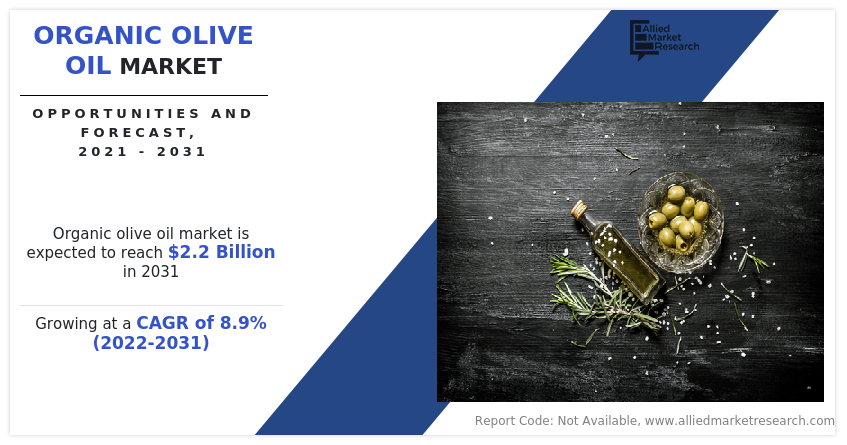
The organic olive oil market is segmented on the basis of product, end user, sales channel, and region. On the basis of product, the market is categorized into extra virgin olive oil and virgin olive oil. According to end user, it is fragmented into food processing, food service, cosmetics and personal care, pharmaceuticals, and others. As per sales channel, the market is divided into B2B suppliers, hypermarkets/supermarkets, grocery store, online retail, and others. Region-wise, the market is analyzed across North America (the U.S., Canada, and Mexico), Europe (Germany, France, UK, Italy, Spain, Netherlands, and Rest of Europe), Asia-Pacific (China, Japan, Australia, South Korea, India, and Rest of Asia-Pacific), and LAMEA (Brazil, Argentina, Saudi Arabia, South Africa, United Arab Emirates, and Rest of LAMEA).
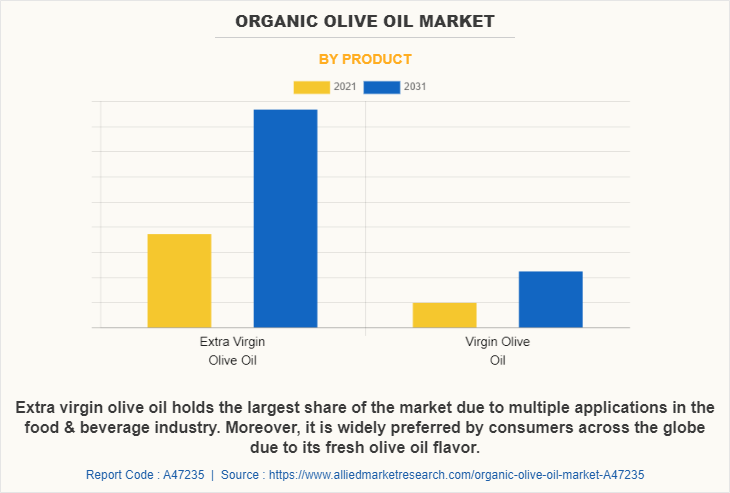
By product, extra virgin olive oil was the highest revenue contributor in 2021 i.e., $738.7 million in 2021 and is expected to reach $1,735.8 million by 2031 at a CAGR of 9.0%. In addition, mechanical and manual pressing is used to create organic extra virgin olive oil. As it retains natural antioxidants and vitamins even after processing, organic extra virgin olive oil is both more expensive and healthier than conventional olive oil. Since it has a more pleasant flavor, natural ingredients, and contains less chemicals, demand for organic extra virgin olive oil is expected to increase significantly throughout the organic olive oil market forecast period. Furthermore, people who seek out higher-quality, healthier olive oil around the world are creating a high demand for extra virgin olive oil that is produced organically.
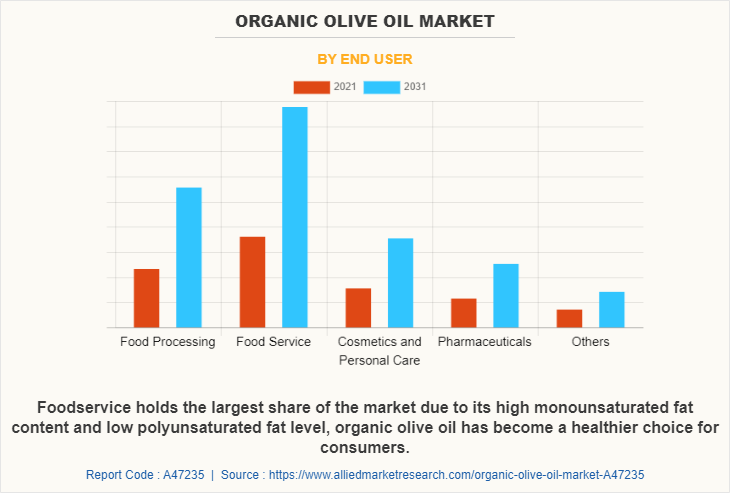
By end user, the food service was the highest revenue contributor in organic olive oil market size i.e., $359.5 million in 2021 and is expected to reach $877.6 million by 2031 at a CAGR of 9.4%. Organic olive oil is considered to be better substitute in food services as compared to other cooking oils present in the market, specifically for sauces and salad dressings. Due to its unusual flavor and great nutritional profile, it is useful in sauces and mayonnaise. When compared to other cooking oils, organic olive oil is not only the widely preferred oil but it is also secure to heat at typical cooking temperatures. Organic olive oil has high heat stability because of its antioxidants. It has gained popularity as a healthy option among customers due to its high monounsaturated fat content and low level of polyunsaturated fat. As a result, using organic olive oil in food services helps the organic olive oil business expand.
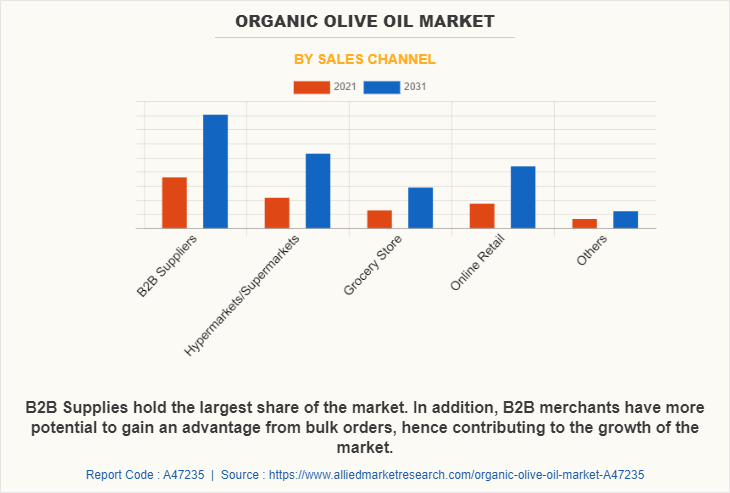
By sales channel, B2B suppliers was the largest revenue in organic olive oil market share in 2021 i.e., $357.4 million in 2021 and is expected to reach $803.5 million by 2031 at a CAGR of 8.5%. Due to the simplicity of ordering in bulk, B2B is frequently used for organic olive oil. Additionally, B2B retailers have a greater opportunity to benefit from volume discounts and thereby support the expansion of the organic olive oil market. Due to its high content of monounsaturated fats, which offer a number of health advantages, organic olive oil is utilized as an ingredient and is valued by consumers. Furthermore, many clients prefer organic olive oil over all of its alternatives when using it in foods and beverages. Additionally, it is employed in the production of cosmetics, cooking oil, and flavored beverages.
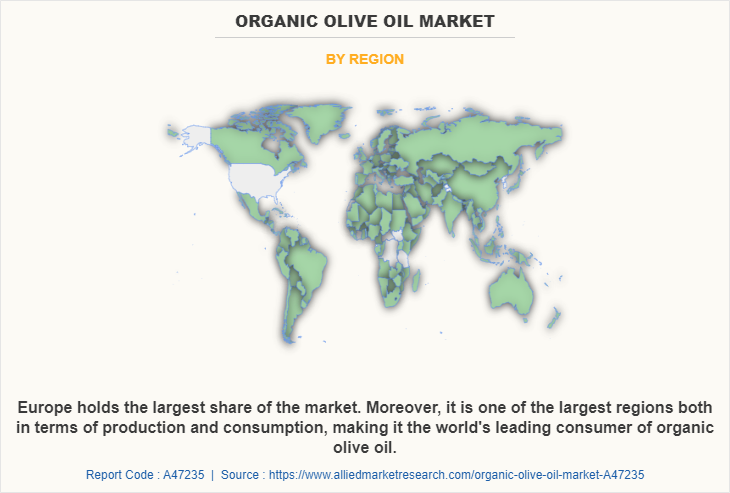
By region, Europe holds largest organic olive oil market share in 2021 i.e., $332.9 million in 2021 and is expected to reach $742.3 million by 2031 at a CAGR of 8.4%. According to the European Commission, the European region produces 67% of the world's olive oil. Moreover, olive tree farming takes up around 4 million hectares of land, mostly in Mediterranean countries such as France, Portugal, Italy, Spain, Greece, Malta, and Cyprus. Furthermore, Europe consumes 53% of the world's olive oil, which fuels the market for organic olive oil. Huge number of olives are sold in France, the UK, Germany, the Netherlands, Switzerland, and Belgium. The market for organic olive oil is also being driven by changes in European consumers' consumption habits, such as a rising interest in healthier food and the Mediterranean diet.
Rapid expansion in food and beverage, cosmetics, and personal care sectors in developing nations, as well as rising public awareness of the advantages of organic olive oil, are some of the reasons driving the organic olive oil industry. The major players operating in the global organic olive oil market are Borges International Group, Colavita USA LLC, Deoleo, S.A., Melissa Kikizas, Minerva Foods, Monini, Olinexo, Nutrinveste SGPS, SA, Pompeian, Inc., and United Olive Oil Import Co.
Key Benefits For Stakeholders
- This report provides a quantitative analysis of the market segments, current trends, estimations, and dynamics of the organic olive oil market analysis from 2021 to 2031 to identify the prevailing organic olive oil market opportunities.
- The market research is offered along with information related to key drivers, restraints, and opportunities.
- Porter's five forces analysis highlights the potency of buyers and suppliers to enable stakeholders make profit-oriented business decisions and strengthen their supplier-buyer network.
- In-depth analysis of the organic olive oil market segmentation assists to determine the prevailing market opportunities.
- Major countries in each region are mapped according to their revenue contribution to the global market.
- Market player positioning facilitates benchmarking and provides a clear understanding of the present position of the market players.
- The report includes the analysis of the regional as well as global organic olive oil market trends, key players, market segments, application areas, and market growth strategies.
Organic Olive Oil Market Report Highlights
| Aspects | Details |
| Market Size By 2031 | USD 2.2 billion |
| Growth Rate | CAGR of 8.9% |
| Forecast period | 2021 - 2031 |
| Report Pages | 342 |
| By Product |
|
| By End User |
|
| By Sales Channel |
|
| By Region |
|
| Key Market Players | melissa kikizas s.a., Nutrinveste SGPS, SA, United Olive Oil Import Co., monini spa, Pompeian, Inc., Deoleo, Olinexo S.L., Borges International Group, Minerva Foods, Colavita, LLC |
Analyst Review
According to the insights of CXOs of leading companies, the consumption of organic olive oil is on the rise owing to a surge in consumption from the commercial segment, majorly in restaurants for frying and sauteing. The high-value food processing industry, where demand for organic olive oil is substantial but yet in its infancy, is the most intriguing and promising of all the sectors. Moreover, the rapid expansion of the food & beverage industry, combined with the wide range of uses for olive oil, is helping to drive up demand for organic olive oil globally. Organic olive oil has a variety of uses besides the food business, including pharmaceutical and personal & cosmetic uses. Organic olive oil is in greater demand in the market owing to increase in consumer expenditure on healthy products.
Governments from numerous countries have taken initiative to maintain the quality of products such as olive that increases the growth in organic olive oil market. In addition, many classifications of olive oils and their attributes are defined by European law. It also offers guidelines for labelling and packaging. To make sure that these regulations are followed and that the goods offered to consumers live up to their expectations, EU Member States conduct controls on samples of olive oil.
Another factor which influences the demand for organic olive oil is rise in demand for olive oil. There is an increase in the demand for organic products as consumers are becoming health conscious. Consequently, the demand for organic olive oil has seen multifold increase in the past four years especially in the developed countries of North America and Europe regions including but not limited to the U.S., Canada, UK, and Germany. The demand for organic olive oil is likely to gain high traction across the world with the growing consumer awareness regarding organic variant of the product and downward pressure on the price point. Furthermore, many new market players are expected to enter the organic olive oil market over the forecast period, attracted by profitable growth and high profit margins.
Europe holds the largest share in 2021 as it is witnessing a significant increase in consumer awareness as a result of global players' competitive strategies. Demand from countries such as France, Germany, and the UK is helping to drive overall growth.
Leading application of organic olive oil market is food service. Organic olive oil has gained popularity as a healthy option among customers because of its high monounsaturated fat content and low level of polyunsaturated fat. As a result, using organic olive oil in food services helps the organic olive oil business expand.
The major players operating in the global organic olive oil market are Borges International Group, Colavita USA LLC, Deoleo, S.A., Melissa Kikizas, Minerva Foods, Monini, Olinexo, Nutrinveste SGPS, SA, Pompeian, Inc., and United Olive Oil Import Co.
The global organic olive oil market size was $932.6 million in 2021, and is projected to reach $2,183.3 million by 2031, registering a CAGR of 8.9% during the forecast period from 2022 to 2031. This is attributed to the rising consumer demand for organically produced olive oil has opened up new market prospects for farmers and is changing the organic olive oil market.
The upcoming trends of organic olive oil Market in the world is prevalence of healthy diet among consumers. Moreover, individual dietary patterns are shaped over time by a variety of social and economic factors that interact intricately.
Post COVID, it is expected that production of organic olive oil would increase to satisfy global consumer demand. The production of organic olive oil is also predicted to increase during the projection period. The organic olive oil supply chain is projected to function normally following a substantial disruption.
Extra virgin olive oil was the highest revenue contributor in 2021 with a CAGR of 9.0% in product type. In addition, extra virgin olive oil is widely available in almost all distribution channels in the market. Due to its flavor of fresh olive oil, it is greatly preferred by customers all over the globe.
China and U.S. have enormous market in the organic olive oil market. This is attributed to the huge number of players in the region offering wide range of products at lucrative prices as well as purchasing power of population in this countries contributing in the growth.
Loading Table Of Content...



